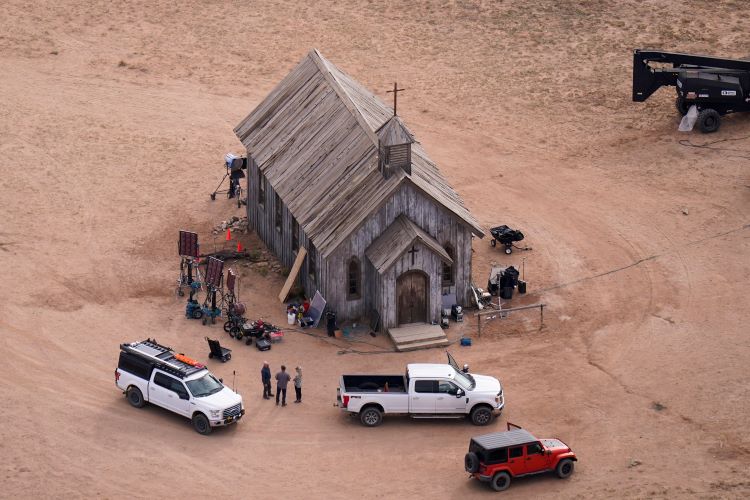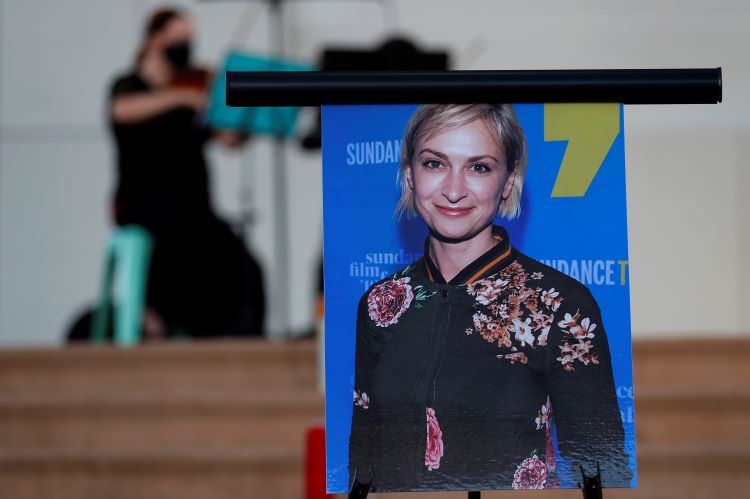'Rust' and a look at criminal liability on movie sets

This aerial photo shows the movie set of Rust at the Bonanza Creek Ranch in Santa Fe, New Mexico, in October 2021. Prosecutors have dropped the possibility of a sentence enhancement that could have carried a mandatory five-year sentence against actor Alec Baldwin in the fatal film set shooting, according to new court filings made public Feb. 20. Photo by Jae C. Hong/The Associated Press.
No profession is free from potential tragedy. It can come in various shapes and sizes to some degree or another, but the notion of someone dying while on a typical job is far from the realm of expectations. While these tragedies are always, well, tragic, death seems to hit on a different level when it happens in what should be a somewhat controlled environment. In that circumstance, as opposed to repercussions stemming from recklessness or a total disregard for safety, it is even more devastating when the death happens in the public eye for all the world to analyze.
‘Rust’
Sadly, that’s precisely the case for cinematographer Halyna Hutchins, who, at the time of her death, was working on the set of the as-yet-to-be-released Western Rust, directed by Joel Souza and starring Alec Baldwin (who also produced and co-wrote the story). However, in October of 2021, production was suspended after Hutchins was shot and killed when Baldwin allegedly fired a prop gun. Filming was set to resume in 2023, but that matter has been complicated by involuntary manslaughter charges filed against Baldwin and Rust armorer Hannah Gutierrez-Reed in New Mexico state court.
Each will face two charges. According to a Deadline report: “[t]he first charge is a fourth-degree felony with sentencing of up to 18 months in jail and a $5,000 fine. The second charge, which is formally an involuntary manslaughter in the commission of a lawful act charge, is also a fourth-degree felony punishable by up to 18 months in jail and up to a $5,000 fine. However, the second charge additionally carries a firearm enhancement. That gives the offense a punishing mandatory five years in state prison if the high-profile defendants are found guilty.”
 Actor Alec Baldwin at the premiere of The Seagull in April 2018 during the 2018 Tribeca Film Festival in New York City. Photo by John Nacion/Star Max/IPx via the Associated Press.
Actor Alec Baldwin at the premiere of The Seagull in April 2018 during the 2018 Tribeca Film Festival in New York City. Photo by John Nacion/Star Max/IPx via the Associated Press.
Baldwin has maintained he didn’t pull the gun’s trigger. Nevertheless, there is apparent scrutiny and speculation as to how a live round found its way into a prop gun prior to the projectile being fired, however that shot actually occurred. For those interested, here is the 551-page report generated via the FBI-assisted investigation.
Regardless of the current posture of the criminal allegations, they have to be cast and analyzed in light of multiple civil suits filed by various individuals allegedly involved in Hutchins’ death. As is often the case, there is quite a bit of finger-pointing going on.
Once one processes the horrible reality of a lost life, various other questions come to the forefront. As mentioned earlier, the plan is still to finish the film and release it to the public. Consequently, it’s easy to wonder how that process can—and whether it should—continue in light of the tragedy surrounding the project.
Some have pointed out the sad reality: These tragic circumstances could possibly result in a bigger box-office draw due to the film’s notoriety in light of Hutchins’ death. As I’ve previously discussed, the general public does seem to have an odd affinity for the macabre, after all. A fair counterpoint exists, though. According to brand expert Eric Schiffer: “For those who brake at accidents on freeways and spend time turning 90 degrees and glued to the scene, they’ll watch it … But for millions of others, ‘Rust’ is dust. They wouldn’t touch it. They’d go to be near it the same as they would a dirty bomb in their neighborhood.”
Tragedy can just as easily create a deterrent. We’ll see.
Regardless, as of the time of writing, Baldwin is still set to continue in his lead role, according to Melina Spadone, an attorney for Rust Movie Productions.
Degrees of culpability
I recently detailed the various degrees of homicide. As such, I’m not going to spill too much digital ink on that discussion. Feel free to give the previous column a read if you need a quick primer prior to continuing here.
What I will reiterate for the uninitiated, though, is that manslaughter is not murder. While both deal with the taking of a human life, that’s about all the allegations have in common. Murder must involve some sort of voluntary or intentional component. Even if one were to solely look at the verbiage used in the charges Baldwin and Gutierez-Reed are facing, the “involuntary” aspect of involuntary manslaughter is a giveaway that we’re dealing with a different beast.
Still, beyond the degrees of homicide, as they relate to those who were formally charged, there are also potential degrees of culpability concerning every individual who had some hand in the ultimate action at issue. Call me crazy, but I find it hard to believe someone of Baldwin’s stature in the world of acting would be loading/unloading his own props for use in scenes. Moreover, there are multiple levels of oversight in place—or that should be in place—to safeguard the parties when firearms are used in major motion pictures.
No doubt, many of those issues will be further fleshed out as the civil lawsuits are litigated.
 A musician plays a violin behind a photograph of cinematographer Halyna Hutchins during a vigil in her honor in Albuquerque, New Mexico, in October 2021. Production is expected to resume this spring on the movie Rust that was halted in October 2021 after a fatal shooting on the set involving actor and producer Alec Baldwin. Photo by Andres Leighton/The Associated Press.
A musician plays a violin behind a photograph of cinematographer Halyna Hutchins during a vigil in her honor in Albuquerque, New Mexico, in October 2021. Production is expected to resume this spring on the movie Rust that was halted in October 2021 after a fatal shooting on the set involving actor and producer Alec Baldwin. Photo by Andres Leighton/The Associated Press.
Not an isolated occurrence
Hutchins’ death on the set of Rust is not the first—nor likely the last—occurrence of someone dying during filming. When I initially heard the news, I immediately thought of Brandon Lee’s death in 1993 on the set of The Crow. It probably came to mind so quickly because that tragedy also involved a prop gun. And while many are likely somewhat familiar with that situation, there are other examples as well.
Take the death of Jon-Erik Hexum. Hexum was a 26-year-old actor who died from a self-inflicted gunshot he suffered on the set of the TV series Cover Up in 1984. While trying to make a joke about his dismay in learning there would be further delays in filming for the day, he held a prop pistol to his head, joking, “Can you believe this crap?” and pulled the trigger. He died six days later.
As far as involuntary manslaughter charges, specifically, we can also look to the death of Vic Morrow and two child actors during the 1982 filming of The Twilight Zone movie. Charges were subsequently levied against director John Landis who took his criminal case to trial and was subsequently acquitted. It appears Baldwin may be headed down the same path, assuming he continues in his claim of not pulling the firearm’s trigger.
Regardless of how the criminal and civil cases are disposed of, the emotional fallout for everyone, including the accused, will be immense. We need to look no further than Michael Massee, the actor who shot and killed Brandon Lee in 1993. Massee took a hiatus until 2005, when he returned to acting. “I don’t think you ever get over something like that,” he stated upon resuming his career.
It’s likely no one involved will ever truly heal mentally and emotionally. At the end of the day, though, they will at least have the opportunity to work through that trauma. The same can’t be said for Hutchins.
See also:
ABAJournal.com: “Prosecutors face obstacles in prosecution of Alec Baldwin and armorer for cinematographer’s death”

Adam Banner
Adam R. Banner is the founder and lead attorney of the Oklahoma Legal Group, a criminal defense law firm in Oklahoma City. His practice focuses solely on state and federal criminal defense. He represents the accused against allegations of sex crimes, violent crimes, drug crimes and white-collar crimes.
The study of law isn’t for everyone, yet its practice and procedure seems to permeate pop culture at an increasing rate. This column is about the intersection of law and pop culture in an attempt to separate the real from the ridiculous.
This column reflects the opinions of the author and not necessarily the views of the ABA Journal—or the American Bar Association.



